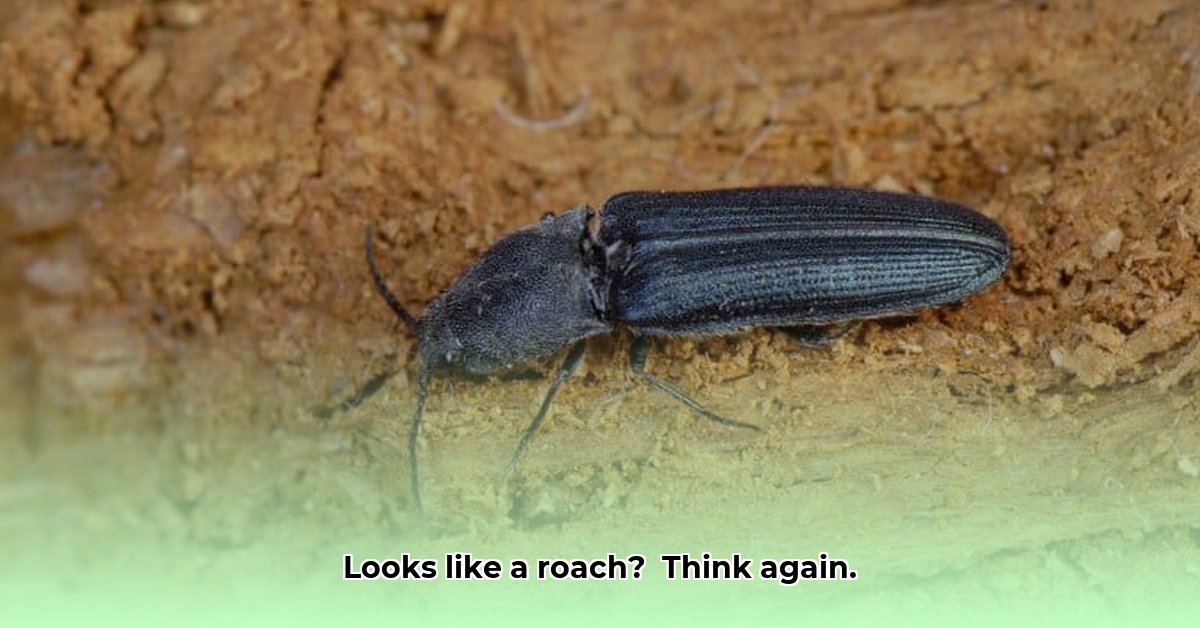Quick Roach Identification
Did something just scuttle across your floor? If your first thought was “cockroach,” don’t panic! Many beetles look surprisingly like roaches. Before you grab the bug spray, let’s learn how to tell these insects apart. This guide will walk you through the key differences, show you pictures, and even tell you a little about their habits.
Roach Recognition: The Telltale Signs
Before we meet the beetle mimics, let’s quickly review what makes a cockroach a cockroach. Common types like the German cockroach are small, tan, and have two dark stripes down their backs. They love warm, damp places. American cockroaches are larger, reddish-brown, and prefer sewers and basements. Oriental cockroaches are shiny black and often have a musty smell. Generally, roaches have flattened bodies and long, waving antennae.
Beetle Mimics: The Usual Suspects and More
Ever seen a dark, quick insect darting across the floor? Your mind probably jumps to “roach,” but it could easily be a ground beetle. These fast-moving insects are frequently mistaken for roaches because of their dark coloring and elongated bodies. However, a closer look suggests key distinctions. Ground beetles have noticeable ridges or grooves on their wing covers and prominent mandibles (jaws)—features roaches lack. Plus, ground beetles are typically found outdoors under rocks or logs, not in your kitchen. They’re actually beneficial insects, preying on other pests in your garden!
Another common case of mistaken identity involves the darkling beetle. These dark brown or black beetles can resemble smaller roaches at first glance. But unlike roaches, they don’t have that characteristic flattened body shape and aren’t nearly as quick. Interestingly, they often play dead when disturbed, a defensive tactic roaches don’t typically use. So, if your suspected “roach” suddenly freezes, it may be a harmless darkling beetle.
Expanding the Lineup: More Roach Doppelgangers
The world of roach impersonators extends beyond ground and darkling beetles. Think you spotted a roach in your pantry? Look again. It might be a spider beetle, with its small, round body. Or perhaps a click beetle, known for its distinctive “clicking” sound and jump when threatened—definitely not typical roach behavior. Even June bugs, with their larger, reddish-brown bodies, can be mistaken for roaches, especially by those unfamiliar with common insect types. Then there’s the confusing case of “water bugs,” a common nickname for the American cockroach. True water bugs are aquatic insects, completely unrelated to cockroaches, adding another layer of complexity to insect identification.
Roach vs. Beetle Quick Comparison
| Feature | Cockroach | Ground Beetle | Darkling Beetle |
|---|---|---|---|
| Body Shape | Flat, oval | Elongated, somewhat flat | Rounded, sometimes longish |
| Color | Tan, Brown, Black | Dark Brown, Black | Dark Brown, Black |
| Antennae | Long, thread-like | Segmented, shorter than body | Segmented, medium length |
| Wings | Usually present | May be present | May be absent |
| Behavior | Fast, avoids light | Fast, usually outdoors | Slow, may play dead |
Roach or Beetle? A Visual Guide
That little critter scurrying across your floor—is it a dreaded cockroach, or a harmless beetle? Before you panic, take a closer look. Many beetles mimic cockroaches. This guide will help you differentiate between these look-alike insects.
Body Shape: Pancake vs. Panzer
Roaches are built for stealth. Their bodies are typically flat and oval, allowing them to squeeze into tight spaces. Beetles, however, are more robust. They often have a harder, more solid body.
Antennae: Whips vs. Clubs
Cockroach antennae are long, thin, and constantly in motion. Beetle antennae are generally shorter, sometimes club-like or saw-toothed.
Wings: Leathery vs. Armored
Roach wings have a leathery texture. Beetles have hard, shell-like outer wings (elytra) that protect the delicate flying wings underneath.
Behavior: Sprinter vs. Explorer
If you see an insect darting across the floor at night, it’s more likely to be a cockroach. They’re known for their speed and nocturnal habits. While some beetles are also active at night, many are slower and more deliberate.
Common Roach Mimics
- Ground Beetles: Found scurrying under rocks? Dark and fast-moving? It’s probably a ground beetle. These beneficial insects have distinct ridges on their wing covers.
- Darkling Beetles: Often confused with roaches, darkling beetles also enjoy hiding under rocks and logs. They come in a wider range of sizes and colors than ground beetles.
Roach vs. Beetle: Key Differences
| Feature | Cockroach | Beetle |
|---|---|---|
| Shape | Flat, oval | Hard, rounded or cylindrical |
| Antennae | Long, thin, constantly moving | Short to medium, often club-like or saw-toothed |
| Wings | Leathery, may be reduced or absent | Hard outer shell (elytra), membranous inner wings |
| Behavior | Fast, often nocturnal, prefers to run | Varied, often slower, prefers to walk |
Some experts suggest that certain beetle species have evolved to mimic cockroaches as a defense mechanism. Ongoing research continues to explore this fascinating area of insect mimicry. While this guide offers a starting point, the insect world is diverse. Consult additional resources or seek expert advice if you’re unsure.
Roach or Beetle? Quick Identification
Spotted a creepy crawler and thinking “cockroach”? Many beetles mimic roaches. This guide provides quick identification tips to help you decide if it’s a roach or a beetle.
Quick Checks
- Body Shape: Roach – flat, oval like a pancake. Beetle – more solid, like a walnut.
- Wings: Roach – like a shawl. Beetle – hard, shield-like elytra.
- Antennae: Roach – long, thread-like, always moving. Beetle – shorter, segmented, like beads.
- Legs: Roach – long, spiny, built for speed. Beetle – shorter, sturdier.
- Color: Roach – reddish-brown or dark brown. Beetle – highly variable, can be bright or metallic.
- Speed: Roach – fast. Beetle – generally slower.
- Young: Roach – nymphs (mini adults). Beetle – larvae (grubs, mealworms).
Common Imposters
- Ground Beetles: Often found outdoors, these dark, fast-moving beetles can be mistaken for roaches. Look for the ridges on their wing covers. They are beneficial predators.
- Darkling Beetles: These dark beetles often play dead when disturbed. They prefer dry environments and are generally harmless.
Roach vs. Beetle: At-a-Glance Guide
| Feature | Roach | Beetle |
|---|---|---|
| Body Shape | Flat, oval | Hard, oval, distinct segments |
| Wings | Cover entire body | Hardened elytra meeting in a line |
| Antennae | Long, thread-like, constantly moving | Shorter, segmented, often beaded |
| Legs | Long, spiny | Shorter, less spiny |
| Color | Brown | Highly variable |
| Speed | Fast | Generally slower |
| Young | Nymphs | Larvae |
By observing these characteristics, you can likely differentiate between a roach and a beetle. If you’re still uncertain, consult a pest control professional.
Common Beetle Look-Alikes: Details and Photos (This section would ideally include high-quality images of each beetle discussed)
Let’s explore those creepy crawlies that might look like cockroaches but are actually beetles.
Roach or Beetle? The Clues
Telling the difference can be tricky. Cockroaches have long, whip-like antennae and flat, oval bodies. They’re also notoriously fast. Beetles can have various antenna shapes—thick, club-shaped, or elbowed. Their bodies are often more robust and many have hard wing covers that meet in a straight line.
Ground Beetles: Garden Guardians
Ground beetles are like tiny tanks in your garden. These fast-moving predators are often dark and shiny. Look for the grooves or lines on their wing covers. They are beneficial insects, eating other insects that could harm your plants.
Darkling Beetles: Desert Dwellers and Mealworm Parents
Darkling beetles, especially those in dry areas, can resemble cockroaches due to their dark, elongated bodies. Some darkling beetle larvae are mealworms. These beetles are mostly scavengers, breaking down organic material.
Wood-Boring Beetles: Built for Wood
Wood-boring beetles have cylindrical bodies and strong jaws perfect for boring into wood. You’ll probably find them near trees or wooden structures, not scurrying across your kitchen floor.
Other Potential Imposters
Other beetles that might trigger a “roach alarm” include Palo Verde root borers (large and dark-colored), Asian longhorned beetles (long antennae), and even June beetles (robust, rounded bodies). Careful observation is key.
Roach vs. Beetle: Quick Guide
| Feature | Cockroach | Beetle |
|---|---|---|
| Antennae | Long, thin, whip-like | Varied |
| Body Shape | Flat, oval | Varied |
| Wing Covers | Absent | Often present, meeting in a straight line |
| Behavior | Fast, prefers dark, damp areas | Varied |
| Typical Habitat | Warm, humid areas | Varied |
Correct identification is crucial. Mistaking a helpful beetle for a pest can lead to unnecessary insecticide use. So, observe closely. It might just be a beetle! Ongoing research constantly updates our understanding of insects, so there can always be exceptions.
Roach vs. Beetle Anatomy: Key Differences
Let’s dive into the details of how to tell roaches and beetles apart.
Roach vs. Beetle: A Tale of Two Bugs
Roaches and beetles have similar basic structures but with distinct modifications.
- Body Shape: Roaches are flat and oval-shaped for squeezing into tight spots. Beetles are often more rounded and stout.
- Antennae: Roach antennae are long, thin, and constantly moving. Beetle antennae are usually shorter, segmented, and can be club-shaped or saw-like.
- Wings: Beetles have hard outer wings (elytra) protecting their flying wings. Cockroaches have leathery wings.
- Legs: Roach legs are built for speed and are covered in tiny spines. Beetle legs are generally smoother and less spiny.
Common Roach Look-Alikes
- Ground Beetles: Look for grooves or lines on their wing covers. They are beneficial garden dwellers.
- Darkling Beetles: Often found in pantries, they are dark and somewhat roach-shaped but move much slower.
Beetle Anatomy Overview
- Head: Contains eyes, antennae, and mouthparts.
- Thorax: Where legs and wings attach.
- Abdomen: Contains vital organs.
By examining these features, you can distinguish between roaches and beetles. This knowledge helps you make informed choices about pest control. Scientific understanding of insect anatomy and behavior is constantly evolving. These basic characteristics provide a strong foundation for identification.
- Glass Lunch Box Containers Offer Healthy, Leak-Proof Meal Prep - December 21, 2025
- Glass Bento Boxes Offer a Healthy, Eco-Friendly Lunch Solution - December 20, 2025
- Glass Bento Containers Make Packing Lunch Easier and Healthier - December 19, 2025










